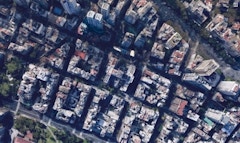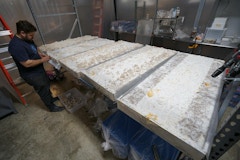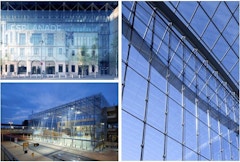
101 results
-
 Projecting imagery onto building facades is not only becoming a marketing necessity for successful urban spectacles but is also altering social urban…
Projecting imagery onto building facades is not only becoming a marketing necessity for successful urban spectacles but is also altering social urban… -

Facade Games
- Paper by James Tice
This paper provides an overview of a course focusing on the façade as taught to architecture students over a twenty-year period. The need for this
-

Terra Cotta Skins
- Paper by Laura B. Garofalo
This paper will address the potential of ornamental architectural terracotta surfaces to mitigate the effects of climate fluctuations that will
-
Insulating Glass Unit Gas Loss
- Paper by Mark K. Schmidt, M.Eng., S.E., Principal and Unit Manager Stephen M. Morse, PhD, P.E., Assistant Professor
Concerns over time-dependent argon permeation through the perimeter edge seals of insulating glass units (IGUs) led the authors to utilize two… -

Retroreflective Coating for Window Blinds
- Paper by Luca Papaiz · Lars Oliver Grobe · Giuseppe De Michele
Solar shading devices are required to find a trade-off between conflicting requirements: Protection from excessive solar gains and glare, daylight
-

Kinetics in Building Facades
- Paper by Sean Cullen · Professor Greg Keeffe
The prominence of climatically responsive building facades through the use of kinetics has proliferated in recent years due to a concern for the
-
Growing Myceliated Facades
- Paper by Thibaut Houette, M. Arch. · Brian Foresi · Christopher Maurer, AIA, NCARB · Dr. Petra Gruber
Today's sustainability in architecture takes into consideration the complete life cycle of buildings and their components, from resource harvesting
-

Architectural Shape Optimization
- Paper by Patricia Edith Camporeale, PhD
This paper explores the architectural shape optimization of typical housing typologies: slab and high-rise residential buildings to reduce primary
-

Design Considerations
- Paper by Stephen M. Morse, Ph.D. · Kayla Natividad, Ph.D. · H. Scott Norville, P.E., Ph.D.
Window glass design using ASTM E 1300 entails determining glass thickness(es) and types so that the window glass construction load resistance
-

Historical Evolution of Responsive Facades
- Paper by Negar Heidari Matin, Ph.D. Candidate, LEED GA · Ali Eydgahi, Ph.D. · Shimming Shyu, Ph.D., RA, LEED AP BD+C · Payam H. Matin, Ph.D.
Responsive facade system is considered a major component of high-performance building envelope that is capable of responding to environmental stimuli
-
Consistency In Glass Design
- Paper by Joshua Schultz, PhD, PE, LEED AP, Associate Professor Grace Dojan, Graduate Student
Glass structural elements have become increasingly common to the point of ubiquity; however, there currently is no universally recognized and… -
The Double Skin Facade
- Paper by Lee A. Fithian, AIA, AICP, NCARB, LEED AP
The largest source of air pollution in North America is the atmospheric boundary layer of a city caused by its urban canyons with pollutants produced
-
Facades Education in the United States
- Paper by Ajla Aksamija, PhD, Professor and Distinguished Chair for Resilient Places Suncica Milosevic, PhD Candidate Gabrielle Brainard, Associate Principal Timothy Brown, Associate Professor
This paper presents the results of a research study, outlining the state of facades education at higher-education institutions across the United… -

Design Principles For Museum Daylight Systems
- Paper by Edgar Stach, PhD · Michael Esposito
This research unlocks the relationship between space, structure and light in nine unique museums developed by architect Renzo Piano. Renzo Piano uses
-

Put Your Sweater On!
- Paper by Eric Haas, AIA, LEED AP BD+C
During the particularly cold first months of 1977 President Jimmy Carter, in what some call “The Sweater Speech,” famously noted how much energy
-

Ceramic Precast Composite Panels
- Paper by Edward Rubio, Edward J. Rubio, Gregory Lucier, Ph.D., Brian Moskow, PE, Sami H. Rizkalla, Ph.D., FACI, FASCE, FEIC, FCSCE, FIIFC, FPCI,
An innovative lightweight ceramic precast composite panel is introduced in this paper that offers the unique benefits of prefabricated off-site… -

End-of-Life Challenges in Facade Design
- Paper by Rebecca Hartwell · Mauro Overend
In recent decades, there has been increased attention to reduce the operational energy performance of buildings. Stringent legislation on building
-

Vertical Louvered Solar Control
- Paper by Clifton Fordham, RA, LEED AP,
Exterior shading devices, when typically used, are horizontal planes that are most effective at the south face of buildings in the northern… -

City Development and Cladding Design
- Paper by Hadil Abdallah, Building Sciences Consultant Girma Bitsuamlak, Professor and Canada Research Chair in Wind Engineering at the University of Western Ontario Hamid Vossoughi, PE, P. ENG., Senior Principal
High-rise buildings in growing cities could become more vulnerable to variations in wind flow due to the continuous changes in urban topology. The… -
Adaptive Facades
- Paper by Walter Haase · Werner Sobek · Enrica Oliva · Michele Andaloro
Facade engineering aims at appropriately balancing the demands imposed by the context and the capabilities inherent to the materials, the geometries


